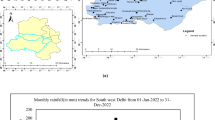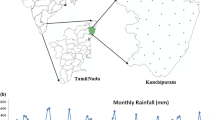Abstract
A study was carried out to investigate the changes in the physicochemical and biological properties of sub-soil river water upon its storage in a man-made reservoir. Palar sub-soil and reservoir water samples were collated fortnightly for a period of 5 years (2010–2014). The open reservoir is used as a reliable raw water source for condenser cooling systems and for the demineralizing (DM) plant input of Fast Breeder Test Reactor (FBTR), Madras Atomic Power Station (MAPS), and other laboratories at Kalpakkam, southeast coast of India. Relatively high nutrient concentration was observed in the Palar sub-soil water, and a significant reduction in average concentration (μmol l−1) of phosphate (Palar 1.92; open reservoir 1.54) and nitrate (Palar 9.78; open reservoir 5.67) was observed from Palar to open reservoir. Substantial increase in pH (Palar 8.05; open reservoir 8.45), dissolved oxygen (mg l−1) (Palar 6.07; open reservoir 8.47), and chlorophyll-a (mg m−3) (Palar 1.66; open reservoir 8.43) values were noticed from the Palar sub-soil water to open reservoir water. It is concluded that sub-soil water with higher nutrient concentrations when stored openly, exposing to the sun, resulted in growth of plants, planktonic, and macrophytes, which led to substantial deterioration in water quality from its utility point of view as a condenser cooling medium and raw water input for DM plant.





Similar content being viewed by others
References
Agarwal, A. K., & Rajwar, G. S. (2010). Physico-chemical and microbiological study of Tehri dam reservoir, Garhwal Himalaya, India. Journal of American Science, 6, 65–71.
Anupkumar, B., Rao, T. S., & Satpathy, K. K. (2001). Microbial fouling of an anion exchange resin. Current Science, 80, 1104–1107.
APHA. (2012). Standard methods for the examination of water & wastewater (22nd ed.). USA: American Public Health Association.
Aston, S. R. (1980). Nutrients dissolved gasses and general biochemistry in estuaries. In E. Olausson & I. Cato (Eds.), Chemistry and biogeochemistry of estuaries (pp. 233–262). New York: Wiley.
Bauerfeind, E., Hickel, W., Niermann, U., & Westernhagen, H. V. (1990). Phytoplankton biomass and potential nutrient limitation of phytoplancton development in the southeastern, North Sea in spring 1985 and 1986. Netherlands Journal of Sea Research, 25(1–2), 131–142.
Boudreaux, K. (2015). Cooling water chemistry programs for high silica waters. Power Plant Chemistry, 17, 82–91.
Boyd, C. E., & Pillai, V. K. (1985). Water quality and fish production. In K. Rengarajan (Ed.), Water quality management in aquaculture (Vol. 22, pp. 1–44). Cochin: CMFRI Special Publication.
Bramha, S. N., Mohanty, A. K., Padhi, R. K., Panigrahi, S. N., & Satpathy, K. K. (2014). Phosphorus speciation in the marine sediment of Kalpakkam coast, southeast coast of India. Environmental Monitoring and Assessment, 186, 6003–6015.
Brungs, W. H. (1973). Literature review of the effects of residual chlorine on aquatic life. Journal of the Water Pollution, 45, 2180–2193.
Chandran, R., & Ramamurty, K. (1984). Hydrobiological studies in the gradient zone of Vellar estuary-I: physico-chemical parameters. Mahasagar, 17, 69–77.
Cheraghi, S. (2015). Effects of raw water composition changes on chemistry control. Power Plant Chemistry, 17, 382–393.
Dalvi, A. G., Al-Rasheed, R., & Javeed, M. A. (2000). Haloacetic acids (HAAs) formation in desalination processes from disinfectants. Desalination, 129, 261–271.
Frossard, E., Condron, L. M., Oberson, A., Sinaj, S., & Fardeau, J. C. (2000). Processes governing phosphorus availability in temperate soils. Journal of Environmental Quality, 29, 15–23.
Gilbert, P. M., Biggs, D. C., & McCarthy, J. J. (1982). Utilization of ammonium and nitrate during austral summer in the Scotia Sea. Deep Sea Research, 29, 837–850.
Gnanadoss, J. J., Satpathy, K. K., Rao, V. N. R., & Nair, K. V. K. (1998). Effects of different bacterial strains on the corrosion of carbon steel. Transactions of the Indian Institute of Metals, 51(5), 327–330.
Gouda, R., & Panigrahy, R. C. (1992). Seasonal distribution and behavior of silicate in the Rushikulya estuary, east coast of India. Indian Journal of Marine Science, 24, 111–115.
Granier, J., Billen, G., & Palfner, L. (2000). Understanding the oxygen budget and related ecological processes in the river Mosel: the RIVERSTRAHLER approach. Hydrobiologia, 410, 151–166.
Hamzah, Z., Ghani, H. A., & Alias, M. (2008). Water quality analysis and its relation to the scaling and corrosion tendency in an open water cooling system. The Malaysian Journal of Analytical Sciences, 12, 380–383.
Harrison, P. J., Hu, M. J., Yang, Y. P., & Lu, X. (1990). Phosphate limitation in estuarine and coastal water of China. Journal of Experimental Marine Biology and Ecology, 40, 79–87.
Kirmeyer, G. J., Kirby, L., Murphy, B. M., Noran, P. F., Martel, K. D., Lund, T. W., Anderson, J. L., & Medhurst, R. (1999). Maintaining and operating finished water storage facilities. Denver: AWWA and AWWARF.
Mavredaki, E., Neofotistou, E., & Demadis, K. D. (2005). Inhibition and dissolution as dual mitigation approaches for colloidal silica fouling and deposition in process water systems: functional synergies. Industrial & Engineering Chemistry Research, 44, 7019–7026.
Mohanty, A. K., Sahu, G., Bramha, S. N., Samantara, M. K., & Satpathy, K. K. (2014). Assessment of temporal variation in coastal water characteristics through multivariate statistics—a case study at southwestern bay of Bengal, India. Indian Journal of Geo-Marine Sciences, 43(9), 1718–1731.
Namdev, G. R., Avinash, B., & Malik, S. (2011). Effect of chemical fertilizers on water quality of irrigation reservoir (Kaliasote reservoir) of Bhopal (M.P.) Current World Environment: An International Research Journal of Environmental Sciences, 6(1), 169–172.
Padhi, R. K., Sowmya, M., Mohanty, A. K., Brahma, S. N., & Satpathy, K. K. (2012). Formation & speciation characteristics of brominated trihalomethanes in seawater chlorination. Water Environment Research, 84(11), 2003–2009.
Padhi, R. K., Satpathy, K. K., & Subramanian, S. (2015). Impact of groundwater surface storage on chlorination and disinfection by-product formation. Journal of Water and Health, 13, 838–847.
Rao, T. S., Kumar, R., More, N. S., Mandal, S. K., Prasad, N., Kakade, C. R., & Datir, S. K. (2016). Microbial corrosion of a process water cooling system in a nuclear power generating unit. Innovations in Corrosion and Materials Science, 5, 53–61.
Reddy, K. R., Wetzel, R. G., & Kadlec, R. H. (2005). Biogeochemistry of phosphorus in wetlands. In J. T. Sims & Sharpley (Eds.), Phosphorus: agriculture and the environment. agronomy monograph (Vol. 46, pp. 263–316). Madison: ASA, CSSA, and SSSA.
Rosas, J. D. (2015). The buffer effect of water in cooling towers. Power Plant Chemistry, 17, 296–305.
Ruttenberg, K. C. (2004). The global phosphorus cycle. In H. D. Holland & K. K. Turekian (Eds.), Treatise on geochemistry, vol.8 (biogeochemistry: W.H. Schlesinger, volume editor), Chapter 14 (pp. 585–643). Amsterdan: Elsevier Science.
Sahu, G., Satpathy, K. K., Mohanty, A. K., & Sarkar, S. K. (2012). Variations in community structure of phytoplankton in relation to physicochemical properties of coastal waters, southeast coast of India. Indian Journal of Geo-Marine Sciences, 41(3), 223–241.
Sahu, G., Mohanty, A. K., & Satpathy, K. K. (2016). Dynamics in mesozooplankton assemblage with respect to environmental variables in the coastal waters of Kalpakkam, southwestern bay of Bengal. Indian Journal of Geo-Marine Sciences, 45(11), 1450–1464.
Santschi, P., Honener, P., Benoit, G., & Brink, M. B. (1990). Chemical process at the sediment – water interfaces. Marine Chemistry, 30, 269–315.
Sarkar, S. K., Satpathy, K. K., Chatterjee, M., Bhattacharya, B., Mohanty, A. K., & Panigrahi, S. N. (2012). Chilika lake: its past and present status. In L. Bengtson, R. Herschy, & R. Fairbridge (Eds.), Encyclopedia of lakes and reservoirs (pp 148–156). Heidelberg: Springer.
Sathish Kumar, S., Suriyanarayanan, A., & Panigrahi, B. S. (2012). Studies on performance of indices in cooling water system. Indian Journal of Chemical Technology, 19, 75–80.
Satpathy, K.K. (1996). Studies on the chemical features of cooling water systems in the context of scaling, biofouling and corrosion control. Ph. D. Thesis, Madras University, Chennai.
Satpathy, K. K., & Nair, K. V. K. (1990). Impact of power plant discharge on the physico- chemical characteristics of Kalpakkam coastal waters. Mahasagar, 23, 117–125.
Satpathy, K. K., Nair, K. V. K., & Mathur, P. K. (1994). Chlorine demand & chemical control of biofouling in power plant cooling system. In M. F. Thompson et al. (Eds.), Recent developments in biofouling control (pp. 396–407). New Delhi: Oxford IBH publication.
Satpathy, K.K., Mohanty, A.K., Prasad, M.V.R., Bhaskar, S., Jebakumar, K.E., & Natesan U. (2006). Impact of biofouling community on the cooling water quality with special emphasis on its nutrient content. Proceedings of the International Conference on Recent Advances in Marine Antifouling Techniques (RAMAT), NIOT, Chennai, India, pp. 326–337.
Satpathy, K. K., Mohanty, A. K., Sahu, G., Biswas, S., & Slvanayagam, M. (2010a). Biofouling and its control in seawater cooled power plant cooling water system—a review. In P. Tsvetkov (Ed.), Nuclear power (pp. 191–242). Rijeka: Intech Publications.
Satpathy, K. K., Mohanty, A. K., Sahu, G., Sarkar, S. K., Prasad, M. V. R., & Venkatesan, R. (2010b). Ecological monitoring of coastal marine environment at southeast coast of India. In E. A. E. I. Nemr (Ed.), Impact monitoring and management of environmental pollution (pp. 339–407). USA: NOVA Science Publication.
Satpathy, K. K., Mohanty, A. K., Sahu, G., Sarguru, S., Sarkar, S. K., & Natesan, U. (2011). Spatio-temporal variation in physico-chemical properties of coastal waters off Kalpakkam, southeast coast of India, during summer, pre-monsoon and post-monsoon period. Environmental Monitoring and Assessment, 180, 41–62.
Satpathy, K. K., Mohanty, A. K., Biswas, S., Selvanayagam, M., & Sarkar, S. K. (2012). Tsunami effect on a coastal lake in India. In L. Bengtson, R. Herschy, & R. Fairbridge (Eds.), Encyclopedia of lakes and reservoirs (pp. 814–820). Heidelberg: Springer.
Satpathy, K. K., Panigrahi, S., Mohanty, A. K., Samantara, M. K., Bramha, S. N., & Selvanayagam, M. (2013). Long-term irreversible changes in a lake ecosystem affected by the Indian Ocean tsunami. Lakes & Reservoirs: Research and Management, 18, 227–238.
Shunsuke, U., Hanawa, S., Kysela, J., & Lister, D. H. (2016). Corrosion of structural materials and electrochemistry in high-temperature water—relationships among water chemistry, corrosion, oxide film and electrochemical corrosion potential. Power Plant Chemistry, 18, 6–17.
Zepp, R. G. (1997). Interactions of marine biogeochemical cycles and the photodegradation of dissolved organic carbon and dissolved organic nitrogen. In A. Gianguzza, E. Pelizzetti, & S. Sammarkano (Eds.), Marine chemistry (pp. 329–352). London: Kluwer Academic Plublication.
Author information
Authors and Affiliations
Corresponding author
Rights and permissions
About this article
Cite this article
Mohanty, A.K., Satpathy, K.K. & Prasad, M.V.R. Changes in sub-soil river water quality upon its open storage—a case study. Environ Monit Assess 189, 399 (2017). https://doi.org/10.1007/s10661-017-6095-z
Received:
Accepted:
Published:
DOI: https://doi.org/10.1007/s10661-017-6095-z




